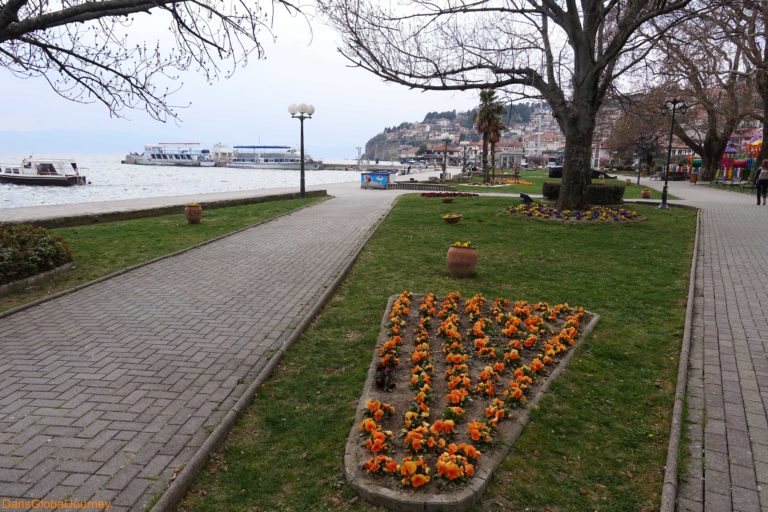The historical city of Ohrid is on the northern shore of the eponymous lake. There you can find a nice old town with many centuries old houses and churches. Moreover, the surrounding scenery is breathtaking as well. In this guide, I tell you about the main sights of the city which are mostly historical ones.
How to get to Ohrid
Ohrid has a small airport with seasonal flights to London, Brussels, Vienna and so on. But most people arrive by bus. You have two options, either a mini bus or a big coach. I would always recommend the coaches, as they’re more comfortable and suited for taller people like me. When I went there by mini bus for 2 hours, my neck hurt the following days.
The most common route is from and to Skopje. For that you can simply go to the bus station and buy a ticket. I did it on the same day, and the buses weren’t full. But it’s always safer to buy tickets in advance.
The only downside of the coaches is the final destination at the bus terminal in Ohrid. It’s on the outskirts of the city far away from the old town. When I rode the mini bus, it stopped directly next to the old town.
The churches of Ohrid
Ohrid has many beautiful churches in its old town which date back to medieval times. Some of them are closed, but you can visit the main ones for a small fee. It’s mostly around 100 Denars.
St. Clement’s Church
St. Clement’s Church near the upper city wall gate is the first church I visited. It’s very beautiful inside and you can feel the history of the place. It was the main church of Ohrid during the Ottoman Empire when St. Sofija Church became a mosque.

St. Clement's Monastery Church
Between Samuel’s Fortress and St. Jovan Church is a church with a very similar name to the first one, St. Clement’s Monastery Church. It was newly built in 2002 and is located directly next to an archeological site. There you can see foundations of a 5th century basilica and the later monastery church which was built by St. Clement.

St. Jovan Church
St. Jovan Church is probably the most beautifully located church in Ohrid. It’s next to a cliff overlooking the lake. Moreover, the church has a small wonderful park surrounding it where you can relax and enjoy the panoramic view of the lake. During my visit in spring, the trees and flowers blossomed which made it even more pretty. The church itself dates back to the 13th century.

St. Sofija Church
St. Sofija Church in the middle of the old town has a very long history. It was built in the 11th century as the cathedral for the archbishop of Ohrid. Later it was used as a mosque and warehouse during the Ottoman Empire. After the collapse of the empire, it was restored into its current state and became a church again.

There are also many smaller churches scattered around the old town. Many of them are even older than their more famous and bigger counterparts. I can remember one church which is beautifully located next to a staircase and many historical houses.

Samuel's Fortress
You can already see this big fortress when you arrive at the old town of Ohrid. It’s on top of a hill overlooking the city. It dates back to the reign of Tsar Samuel when Ohrid was the capital of the First Bulgarian Empire in the 10th century. But archeologists showed that there was originally a fortress from the 4th century BC.
The fortress has an entrance fee of 30 Denars. When you go inside, you can see that there’s basically not much to see. Only the walkable wall and some ruins remain. But for me it’s still a highlight, because the view of Ohrid and the scenery of the lake are breathtaking. You can walk around a long part of the fortress wall and get some beautiful views to enjoy and remember.

The old town
The overall lakefront and old town area are highlights itself. It’s great to walk inside the hilly area of the old town and get lost in its narrow alleys. Another unique feature are the lanterns of the old town which are shaped in the form of the traditional houses that you can spot everywhere. There’s also a longer pedestrian shopping street with many small shops where you can find souvenirs and food. I’ve eaten nearby this street a couple of times.

The lakeside
You can’t talk about the city of Ohrid without saying something about the lake. It stretches beautifully into the distance next to the big mountains. You can walk around a nice park area for a few kilometres all the way along the lake. I walked for probably three kilometres to the east before I turned around and walked back. The lakeside also offers some picturesque views of the old town, so don’t forget your camera.
